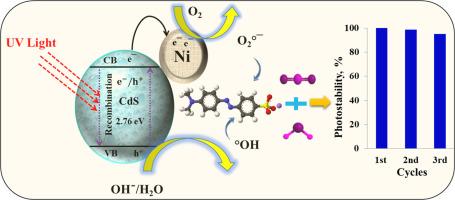紫外光下Cu和ni掺杂CdS纳米复合材料光催化降解甲基橙染料:反应器性能和动力学分析
IF 3.9
3区 工程技术
Q3 ENERGY & FUELS
Chemical Engineering and Processing - Process Intensification
Pub Date : 2025-09-18
DOI:10.1016/j.cep.2025.110560
引用次数: 0
摘要
低效处理的废水对环境造成了巨大的挑战,促使人们对新型光催化剂的开发进行了深入的研究。虽然CdS光催化剂得到了广泛的研究,但其有限的稳定性和快速的载流子重组阻碍了其光催化性能。本研究通过简单的化学沉淀法合成了Cu和ni掺杂的CdS纳米复合材料,以提高紫外光照射下的光催化效率。利用XRD、SEM-EDX、FTIR和XPS对其结构、形貌和光学性质进行了表征,证实其为六方纤锌矿结构(平均晶粒尺寸为22.0-30.0 nm)、元素分散度均匀的球形形貌、O-H拉伸带以及新化学态的存在。光催化降解甲基橙染料(MO) (10 mg l-1)的效率分别为77.7% (CdS)、81.3% (CdS- cu)、93.8% (CdS- ni)和83.0% (CdS- cu - ni)。值得注意的是,在加入1.0 mL H2O2时,CdS-Ni实现了100%的降解。反应符合准二级动力学,反应速率常数为0.0079 min-1,催化剂在多次重复使用循环中表现出良好的稳定性。光催化活性的增强主要是由于带隙的缩小、光捕获能力的提高和电子-空穴对复合的减少。这些结果证明了CdS-Ni纳米复合材料作为处理染料污染废水的有效光催化剂的潜力。本文章由计算机程序翻译,如有差异,请以英文原文为准。

Enhanced photocatalytic degradation of methyl orange dye under UV light using Cu and Ni-doped CdS nanocomposites: Insights into reactor performance and kinetic analysis
The inefficient treated wastewater poses a significant environmental challenge, which drives intensive research toward the development of novel photocatalysts. While CdS photocatalysts have been widely studied, their limited stability and fast charge carrier recombination hinder photocatalytic performance. In this study, Cu and Ni-doped CdS nanocomposites were synthesized via a simple chemical precipitation route to improve photocatalytic efficiency under UV irradiation. The structural, morphological, and optical properties were characterized using XRD, SEM-EDX, FTIR, and XPS, confirming a hexagonal wurtzite structure (average crystalline size: 22.0–30.0 nm), spherical morphology with homogeneous elemental dispersion, O–H stretching bands, and the presence of new chemical states. Photocatalytic degradation of methyl orange dye (MO) (10 mg l-1) showed efficiencies of 77.7 % (CdS), 81.3 % (CdS-Cu), 93.8 % (CdS-Ni), and 83.0 % (CdS-Cu-Ni) after 3.0 h of UV exposure. Notably, CdS-Ni achieved 100 % degradation upon the addition of 1.0 mL of H2O2. The reaction followed pseudo-second-order kinetics, with a reaction rate constant of 0.0079 min-1, and the catalyst demonstrated good stability over multiple reuse cycles. The enhanced photocatalytic activity was primarily attributed to the narrowed bandgap, increased light-harvesting capability, and reduced electron-hole pair recombination. These outcomes demonstrate the potential of CdS-Ni nanocomposites as effective photocatalysts for the treatment of dye-contaminated wastewater.
求助全文
通过发布文献求助,成功后即可免费获取论文全文。
去求助
来源期刊
CiteScore
7.80
自引率
9.30%
发文量
408
审稿时长
49 days
期刊介绍:
Chemical Engineering and Processing: Process Intensification is intended for practicing researchers in industry and academia, working in the field of Process Engineering and related to the subject of Process Intensification.Articles published in the Journal demonstrate how novel discoveries, developments and theories in the field of Process Engineering and in particular Process Intensification may be used for analysis and design of innovative equipment and processing methods with substantially improved sustainability, efficiency and environmental performance.

 求助内容:
求助内容: 应助结果提醒方式:
应助结果提醒方式:


